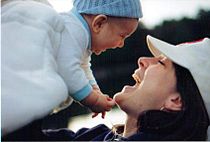دلبستگی کودک - ویکیپدیا، دانشنامهٔ آزاد


دلبستگی کودک یا دلبستگی در کودکان (به انگلیسی: Attachment in children)، «یک غریزه زیستشناختی است که در آن زمانی که کودک تهدید یا ناراحتی را احساس یا درک میکند، نزدیکی به یک شخصیت دلبسته جستجو میشود. رفتار دلبستگی پاسخی توسط شکل دلبستگی را پیشبینی میکند که تهدید یا ناراحتی را از بین میبرد.»[۱][۲][۳] دلبستگی همچنین کارکرد در دسترس بودن را توصیف میکند، که درجهای از پاسخگویی شخصیت معتبر به نیازهای کودک و به اشتراک گذاشتن ارتباط با آنها است. دلبستگی دوران کودکی میتواند ویژگیهایی را تعریف کند که به احساس کودک، شکلهای تنظیم هیجان و شیوهٔ برقراری روابط با دیگران را شکل میدهد.[۴] دلبستگی در همه پستانداران تا حدی، به ویژه پستانداران دیده میشود.
نظریه دلبستگی به درک جدیدی از رشد کودک رسیدهاست. کودکان الگوهای دلبستگی متفاوتی را بر اساس تجربهها و برهمکنشها با مراقبان خود در سنین پایین ایجاد میکنند. چهار دستهبندی دلبستگی مختلف در کودکان شناسایی شدهاست: دلبستگی ایمن، دلبستگی مضطرب-دوسوگرا، دلبستگی مضطرب-اجتنابی و دلبستگی ناسازگار. نظریه دلبستگی به نظریه غالبی تبدیل شدهاست که امروزه در مطالعه رفتار نوزادان و کودکان نوپا و در زمینههای بهداشت روانی نوزادان، درمان کودکان و زمینههای مرتبط مورد بهرهبرداری قرار میگیرد.
منابع
[ویرایش]- ↑ Prior & Glaser (2006) Understanding Attachment and Attachment Disorders, London: JKP, p.17
- ↑ Bowlby, J. (1960). "Separation Anxiety". Int J Psychoanal. 41: 89–113. PMID 13803480.
- ↑ Tronick, Morelli, & Ivey, 1992, p.568. "Until recently, scientific accounts … of the infant's early social experiences converged on the view that the infant progresses from a primary relationship with one individual... to relationships with a growing number of people... This is an epigenetic, hierarchical view of social development. We have labeled this dominant view the continuous care and contact model (CCC...). The CCC model developed from the writings of Spitz... , Bowlby... , and Provence and Lipton... on institutionalized children and is represented in the psychological views of Bowlby...[and others]. Common to the different conceptual frameworks is the belief that parenting practices and the infant's capacity for social engagement are biologically based and conform to a prototypical form. Supporters of the CCC model generally recognize that the infant and caregiver are able to adjust to a range of conditions, but they consider the adjustments observed to reflect biological variation. However, more extreme views (e.g. , maternal bonding) consider certain variants as nonadaptive and as compromising the child's psychological development. Bowlby's concept of monotropism is an exemplar of the CCC perspective..." (Tronick, Morelli, & Ivey, 1992, p. 568).
- ↑ Kayastha, P. (2010). Security of attachment in children and adolescents. Bangalore: Elsevier B.V.


 French
French Deutsch
Deutsch